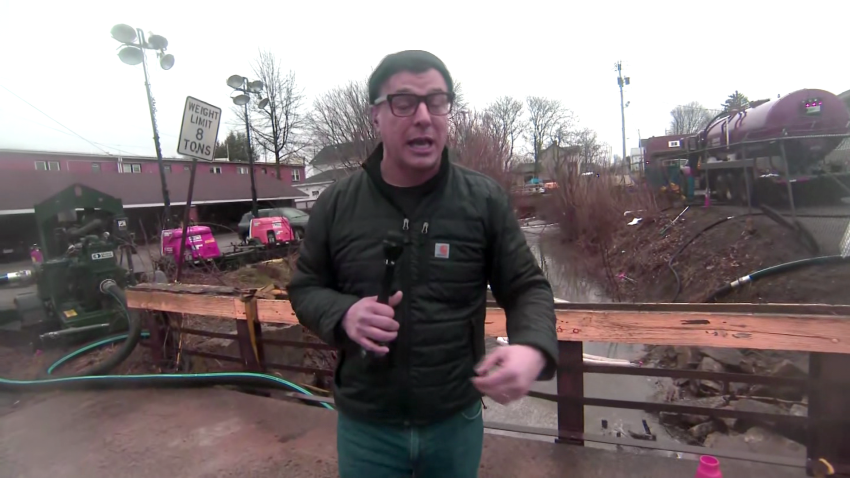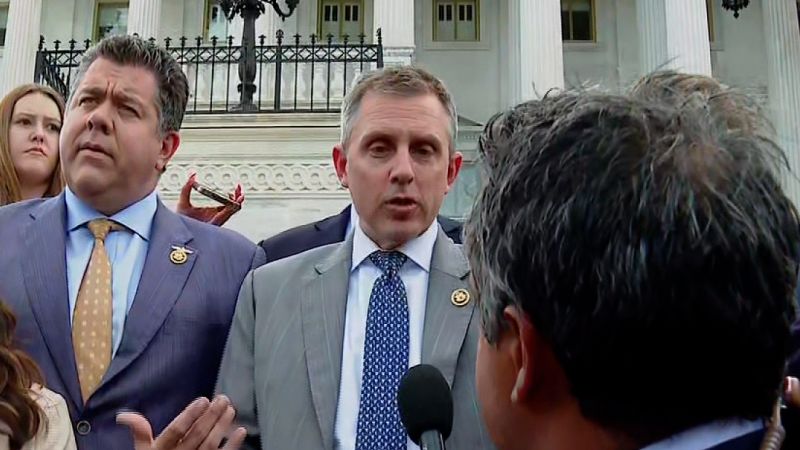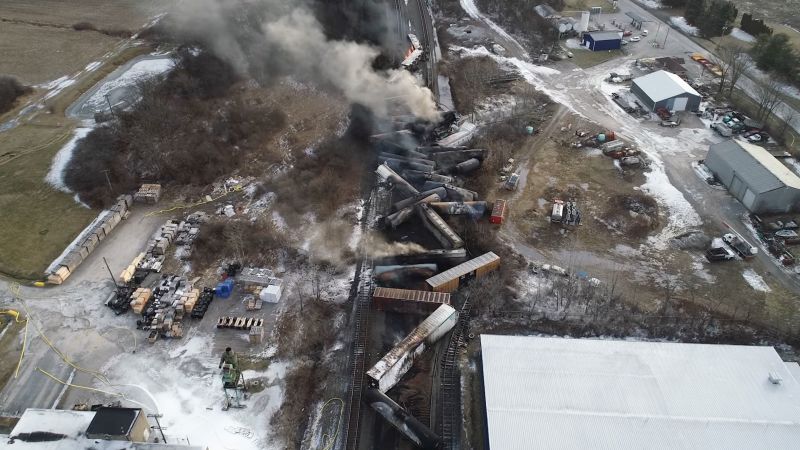CNN
—
Nearly three weeks since the toxic train wreck in a small Ohio community, the National Transportation Safety Board is expected to release its preliminary report on the derailment.
The NTSB report was described to CNN by a source familiar with the investigation as a “tight presentation of the facts” – and it comes amid mounting questions about how Norfolk Southern, the train’s operator, has handled the incident and the mechanical failures that may have preceded it.
Residents of the East Palestine, Ohio, community, voiced their frustrations during a CNN town hall Wednesday night where they spoke to both Ohio Gov. Mike DeWine and Norfolk Southern CEO Alan Shaw, demanding answers about the derailment and the cleanup since, and reassurance about their future.
Jim Stewart, who has lived in East Palestine for more than six decades, said the wreck burned down his dreams of retiring soon and selling his house, adding he worries what the home’s value now looks like. He said he’s afraid to take his dog out, because of the strong stench, and wonders if he’ll be able to plant his tomatoes during the summer, after officials said the soil was also contaminated by chemicals.
“It’s made me an angry man,” he told Shaw. “Your company stinks.”
It’s been nearly three weeks since the train carrying hazardous chemicals derailed in the village. To help prevent a potentially worse disaster, crews conducted the controlled release of toxic vinyl chloride – a chemical linked to an increased risk of certain cancers – from several train cars that contained the chemical and then burned it off in a pit. The result was a plume of black smoke that lingered over East Palestine for days.
Though an evacuation order was lifted five days after the derailment and officials have repeatedly said the air and municipal water is safe, residents on Wednesday reported a variety of ailments, from bloody noses to dizziness and vomiting.
Community members said their lives have been completely upended by the wreck and they feel unsafe in a village they have long called home.
“I don’t feel safe because I don’t know what the future holds for my town,” said lifelong resident Jessica Conard, whose family has lived in East Palestine for generations. “This has the potential to really decimate a small town like us.”
“I just want to feel safe in my town again,” she added.

NTSB to release preliminary report on Ohio train derailment tomorrow
The NTSB is expected to release its report some time after 10 a.m., the agency said in a news release.
While NTSB preliminary reports do not include a definitive cause nor draw conclusions, federal investigators probing the wreck have said surveillance video captured a wheel of the train bearing “in the final stage of overheat failure moments before the derailment.”
In a February 14 statement, the NTSB said the “suspected overheated wheel bearing” was collected for examination from engineers.
The train slowed down dramatically after the first signs of the potential wheel bearing overheat appeared on surveillance video – roughly 21 miles before it derailed – according to a new CNN analysis of surveillance video and Department of Transportation documents.
The train had been traveling at an average speed of 49 miles per hour between Alliance, Ohio, and Salem, Ohio – but then slowed down to nearly half that speed between Salem and East Palestine.
CNN calculated the train’s average speed by using surveillance video time stamps that showed the train’s positions at specific points on the track.
The slowdown was well below the “typical speed range” for a train traveling along that stretch of track, according to documents filed in 2020 with the Federal Railroad Authority.
It’s unclear what prompted that dramatic slowdown.
CNN reached out to Norfolk Southern but did not immediately receive a response.
NTSB spokesperson Jennifer Gabris told CNN “this information will be part” of Thursday’s preliminary report.
During CNN’s town hall, several residents spoke of health problems their families began experiencing after the toxic wreck.
Courtney Newman, a mother and teacher in East Palestine, said since her family returned home, her son has had “bloody noses every day,” and she has had “skin issues.”
Another resident, Josh Hickman, said he is still staying at a hotel as he doesn’t feel safe returning home, but he’s had to come into the village a few times and experienced symptoms including headaches, dizziness and blood from his nose – and on Tuesday, sought treatment at the emergency room.
A third resident reported eyes burning, headaches and vomiting since the derailment.
In addition to vinyl chloride, chemicals of concern at the site include phosgene and hydrogen chloride, which are released when vinyl chloride breaks down; butyl acrylate; ethylene glycol monobutyl ether acetate; and 2-ethylhexyl acrylate, according to the US Environmental Protection Agency. All these chemicals can change when they break down or react with other things in the environment, creating a stew of potential toxins.
“We’re getting everything we need, except answers,” East Palestine Mayor Trent Conaway said Wednesday. “We need answers, as far as the health concerns.”
During the town hall, Ohio’s governor stressed he did not want to minimize any medical issues potentially linked to the derailment, saying that’s the reason he requested medical experts to the community.
Medical teams from the US Centers for Diseases Control and Prevention and the US Department of Health and Human Services will also be on the ground this week at DeWine’s request, he said Friday.
The state also opened a health assessment clinic Tuesday for residents who worry their symptoms could be linked to the wreck. The clinic includes nurses, toxicologists and mental health professionals, and can provide residents with referrals if needed, according to the Ohio Department of Health.
Despite repeated questions from frustrated residents, Shaw, the CEO of Norfolk Southern, declined answering questions regarding the wreck investigation and details about what may have caused the derailment, saying he was “prohibited” from talking about the probe.
“I’m terribly sorry that this has happened to this community,” he said. “What I can do, and what I will do, is make it right.”
“We’re going to get the clean-up right, we’re going to reimburse the citizens, we’re going to invest in the long term health of this community,” Shaw said. “I’m going to see this through, and we’re going to be here. And we’re going to work with these community leaders to help you thrive.”
“We’re looking for ideas from the community on where we can help,” he added.
Norfolk Southern has been ordered by the US Environmental Protection Agency to fully clean up the wreck – or face expensive consequences.
“EPA has special authority for situations just like this where we can compel companies who inflict trauma and cause environmental and health damage to communities, like Norfolk Southern has done, to completely clean up the messed that they’ve caused and pay for it,” administrator Michael Regan said.
According to Regan, Norfolk Southern will be required to:
- provide a descriptive work plan on how they plan to clean up the water, soil and debris,
- reimburse the EPA for providing residents a cleaning service of their homes and businesses,
- show up to public meetings and explain their progress.
“If Norfolk Southern decides that they don’t want to follow the order, EPA will step in, so that there’s no break in service, perform these duties, while fining the company up to $70,000 a day and then we’ll recoup our cost on the back end,” Regan said during Wednesday’s town hall. “And the law gives us the authority to charge Norfolk Southern up to three times the amount that the cleanup will cost us.”
The ongoing clean up efforts at the derailment site include removing contaminated soil and water from under the railroad tracks.
The contaminated soil became a point of contention last week after a public document sent to the EPA on February 10 did not list soil removal among completed cleanup activities. It is not yet known what significance or impact the soil that was not removed before the railroad reopened on February 8 will have had on the surrounding areas.
DeWine said 4,588 cubic yards of soil and 1.1 million gallons of contaminated water have been removed so far from East Palestine. The railroad tracks will also be taken up so that the soil can be removed, the governor has said.
In a Wednesday update, DeWine reiterated test results showed water coming from East Palestine’s municipal system was safe to drink, but said officials will continue testing the water weekly to ensure it remains clean.
Health authorities have also tested water from at least 74 private wells and those results are pending. Residents who get their water from private wells – which may be closer to the surface than municipal wells – should continue drinking bottled water until they receive their test results, the governor said.
Officials are also continuing to treat contamination in a creek that runs through the town, while water quality in a second body of water in the area “continues to improve, according to the governor. No vinyl chloride was detected in the waterways, the update said.
But some residents remain hesitant to believe what they’ve been told.
“Since I (got) home from evacuating, I’m still not using the water because I never know if … they’re telling the truth or it’s a lie,” resident Nene Stewart said during the town hall. “I use bottled water. I can’t. I’m not trusting what they’re saying. I don’t know who’s telling the truth.”







More News
But How Does the Worm Get in Your Brain?
Greene Moves to Oust Johnson, Teeing Up Another Historic Vote
An Inside Look at the Student Takeover of Columbia’s Hamilton Hall